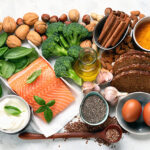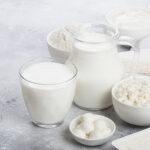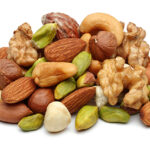News Briefs
Dairy foods and weight
Although the jury is still out, the bulk of the evidence suggests that dairy foods play a beneficial role in weight management according to Dr Marta Van Loan who has reviewed some of the most recent scientific evidence in the Journal of the American College of Nutrition. Her umbrella review covers observational and retrospective studies with adults as well as children and adolescents plus randomized clinical trials on body weight and composition, energy expenditure, substrate oxidation and fecal fat loss. She turns to research from animal and in vitro studies to investigate possible mechanisms.

Dr Marta Van Loan
In her conclusion she says: ‘In general, data from observational studies shows that dairy is a healthy, nutrient-rich food that, as part of a balanced diet, is inversely associated with body weight and body fat in children, adolescents and adults. In addition, several randomized clinical trials have demonstrated that diets including three servings of milk, yogurt and cheese per day enhance body weight and/or body fat loss in obese and overweight adults during caloric restriction and when dairy and/or calcium intakes are increased from inadequate to adequate. Moreover, weight loss was achieved in all clinical studies examining the role of dairy in weight loss where caloric-restriction was induced.’
Calcium, vitamin D and diabetes risk
Getting enough calcium and vitamin D for strong bones is a message we are all pretty familiar with. But there’s more. Emerging evidence suggests that getting enough of them also plays a role in reducing the risk of type 2 diabetes and metabolic syndrome. And many of us aren’t getting enough.
Looking at the role of vitamin D and calcium in type 2 diabetes in a systematic review and meta-analysis published in the Journal of Clinical Endocrinology & Metabolism Dr A. G. Pittas and colleagues found that:
- ‘Observational studies show a relatively consistent association between low vitamin D status, calcium or dairy intake, and type 2 diabetes or metabolic syndrome.’
- ‘Evidence from trials with vitamin D and/or calcium supplementation suggests that combined vitamin D and calcium supplementation may have a role in the prevention of type 2 diabetes only in populations at high risk (i.e. those with impaired glucose intolerance).’
- ‘The available evidence is limited because most observational studies are cross-sectional and did not adjust for important confounders, whereas intervention studies were short in duration, included few subjects, used a variety of formulations.’
In examining the intake of milk and milk products specifically between type 2 diabetes and metabolic syndrome, the researchers found there was a lower risk for type 2 diabetes among individuals with the highest dairy intake (3–5 servings per day) compared to those getting less than 1½ servings each day. They make the point that ‘although calcium and vitamin D are important components of dairy products, their contribution to the measured outcomes cannot be separated from other components in dairy products.’
You can find links to recent papers on dairy foods and type 2 diabetes and metabolic syndrome published in peer-reviewed journals on Canada’s Dairy Nutrition website HERE and in the European Dairy Association’s (EDA) quarterly newsletter, Dairy Nutrition Digest.
Dairy foods may reduce diabetes risk
A diet with a higher intake of milk and a lower intake of staples like bread and rice may reduce the risk of developing type 2 diabetes suggests the latest findings from the Shanghai Women’s Health Study published in the International Journal of Epidemiology. The researchers identified three patterns: cluster 1 – women with the highest intake of dietary staples (rice, bread, and associated products); cluster 2 – women with the highest intake of dairy milk; cluster 3 – women with the highest energy intake. They found women in cluster 2:
- Were less likely to have abdominal obesity or hypertension when they entered the study compared with women in clusters 1 and 3.
- Had a 22% lower relative risk for developing type 2 diabetes during follow-up (when cluster 1 women were used as a reference).
Milk and recovery after exercise
‘Several studies report that milk can be just as effective as sports drinks to aid recovery in athletes,’ says Dr Emma Stevenson. ‘Cockburn and colleagues found having plain semi-skim milk after exercise that had resulted in muscle damage was more effective than a carbohydrate sports drink at lessening the decrease in muscle performance and the increase in creatine kinase and myoglobin (these are blood markers of muscle damage).’
However, at the 2008 Beijing Olympic Games, it was chocolate milk not plain semi-skim milk that was conspicuous by its presence with numerous elite athletes regularly seen drinking it. In 2006, Karp and colleagues had reported in the Journal of Sport Nutrition and Exercise Metabolism that chocolate milk not only reduces muscle damage after exercise, but can also improve subsequent endurance capacity in well trained cyclists. It’s the extra sugars in chocolate milk that make it better for recovery than plain milk they speculated.
In a 2009 study published in Applied Physiology, Nutrition and Metabolism, nine trained male cyclists cycled 51% and 43% longer after drinking chocolate milk than after carbohydrate and fluid replacement drinks respectively despite the beverages having very similar calorie (or energy) contents. For this study, the athletes completed a glycogen depletion workout, drank one of the three test beverages during a four-hour recovery period, and then cycled in an endurance capacity trial over three experimental trials. ‘This difference could be attributable to differences in carbohydrate type and (or) fat content between the beverages,’ write the study authors.
‘It is most likely that the combination of carbs and protein provided in milk is the reason why it is such a good recovery product for athletes,’ says Dr Stevenson. ‘Skim or reduced fat milk (plain or chocolate) also has a low GI and so can be a healthier alternative to sports drinks (yes, even with the added sugar in the chocolate drink).’

Photo: Cass Mortimer Eipper, Timothy O’Donnell, Emma Sandall and Joseph Simons from dance company Ludwig: www.ludwig.com.au
Milk, muscle gain and fat loss
A recent study by researchers at Canada’s McMasters University has found that women, like men, can reap the benefits of skim milk when exercising and training. The March issue of Medicine and Science in Sports and Exercise found women who drank 2 cups of skim milk immediately after resistance exercise gained more muscle mass that those who drank a sports drink. The milk drinkers also benefited from a reduction in fat mass; the sports drink drinkers didn’t. For the study, the women exercised five days a week for 12 weeks and changes in their body composition were measured. ‘We believe there are two main constituents (among many other minor ones) responsible for the beneficial effects on muscle gain and fat loss,’ says lead author Andrea Josse, ‘protein and calcium/vitamin D.’
Nutrition profiling
US First Lady Michelle Obama speaking at the Grocery Manufacturers Association Conference said: ‘The vast majority of Americans rely on labels to help them decide what foods to buy. But we know those labels aren’t always as helpful as they could be. And it’s hard enough to figure out whether any one food item is healthy. It’s even harder to compare items. And folks just don’t have the time to line products up side by side and figure out whether these compare or not. And they shouldn’t have to … We need clear, consistent, front-of-the-package labels that give people the information they’ve been asking for, in a format that they understand’

Michelle Obama
While we wait for those ‘clear, consistent, front-of-the-package labels,’ US-based Hannaford Supermarkets did something about it. They introduced the Guiding Stars nutrition profiling scheme to make it easier and quicker for people to identify the healthier options in their stores. With the exception of bottled water, alcoholic beverages, coffee, tea, spices, all edible products are rated. The more nutritional value a food has for its calories, the more stars it gets on a good, better, best nutritional value scale of zero to three. Many get zero.
Does it work? Well it may not be the perfect system (it does not take account of a food’s GI value for example), but research recently published in the American Journal of Clinical Nutrition suggests that it has had a positive influence on healthier food choices. The study was conducted by Dr Lisa Sutherland and colleagues who were on the program’s Scientific Advisory Panel at the time the research was undertaken.
‘We used purchasing data from 2006 to 2008 from Hannaford Supermarkets,’ said Sutherland, ‘and examined the data before the Guiding Stars scheme was introduced and one and two years after it was implemented. When we looked at ready-to-eat breakfast cereals as a case study, we found that purchase of star-rated cereals by shoppers significantly increased at one-year and continued to increase in year-two. Although we did not measure individual diet, the purchasing of low-sugar, high-fiber cereals increased greatly after program implementation. This finding is of particular importance to our understanding the potential impact of such programs on consumer diet’.

Betts Fitzgerald, Managing Director of Guiding Stars Licensing Company, told GI News that the program ‘has now been implemented in more than 1500 supermarkets in the US including Hannaford, Food Lion, Bloom and Sweetbay. Kings Super Markets will launch Guiding Stars in 2010.’ Read more at www.guidingstars.com.
GI Group: If you shop in these supermarkets, please tell us if you find nutrition profiling like this helpful and whether seeing one, two, three or no stars has changed any purchasing decisions.







